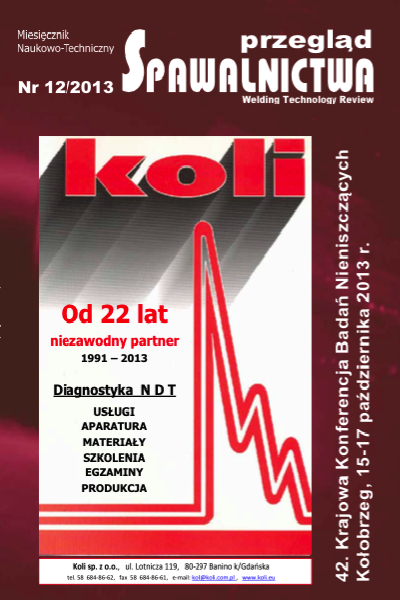Ultrasonic fields and inspection of composites
##plugins.themes.bootstrap3.article.main##
Abstrakt
Composites are widely used in aerospace, shipbuilding, automobile industry and other fields. Reliability and effectiveness of composites whose primary structural components are fiber-reinforced material need a significant demand for nondestructive testing. Mathematical modeling has evolved as an important tool to providing an aided analysis and optimize experimental setups [1]. Modeling will help to reveal the quantitative features relationship in ultrasonic physical phenomena and to accelerate the development of new NDT techniques. Gaussian beam superposition technique has been developed for homogeneous anisotropic materials and extended to simulate in inhomogeneous structures [2]. Modeling the transducer generated sound beam in composites is very difficult, especially when the geometry structure and the material component are complex. However, methods based on the paraxial approximations that model the transducer wave field with a superposition of Gaussian beams are computationally efficient and well behaved[3]. In this paper, the multi-Gaussian beam model for calculating ultrasonic acoustic field in anisotropic material is introduced and developed to calculate the propagation and penetration of Gaussian beams in composite materials. It is presented that numerical simulations and experimental results of transmitted ultrasonic field for composites with different thickness are effective. Accuracy of the proposed model is verified by comparing model-based predictions with experimental results. Automated ultrasonic scanning technology by means of immersion tank and squirter has been extensively applied in composite quality inspection [4]. But the reliability and repeatability of inspection results are strongly depend on the understanding of ultrasonic propagation model in composites [5].
Pola ultradwiękowe i badania kompozytów
W pracy przedstawiono wyniki symulacji komputerowej i wyniki pomiarów rozkładu ciśnienia akustycznego fal przechodzących przez płyty kompozytowe o różnych grubościach. Symulacje wykonano dla głowicy ogniskującej pracującej w zanurzeniu. Wpływ kompozytu na kształt wiązki przejawia się głównie w skróceniu długości ogniskowej. W badaniach eksperymentalnych zastosowano głowic o częstotliwości 1 MHz pracujące w zanurzeniu, a badaniu podlegały rozkłady pola akustycznego po przejściu fal przez zbrojone włóknem węglowym próbki kompozytowe o grubościach od 10 do 25 mm. W drugiej części przedstawione są wyniki badania zakrzywionych próbek kompozytowych zawierających wady sztuczne. Badania wykonano metodą przepuszczania głowicami ze sprzężeniem strumieniem wody. Głowice prowadzone były przez dwa współpracujące roboty.
Pobrania
##plugins.themes.bootstrap3.article.details##
Creative Commons CC BY 4.0 https://creativecommons.org/licenses/by/4.0/
Artykuły czasopisma Welding Technology Review (Przegląd Spawalnictwa) publikowane są w otwartym dostępie na licencji CC BY (licencja Creative Commons Uznanie autorstwa 4.0 Międzynarodowe). Licencja CC BY jest najbardziej otwartą dostępną licencją i uważaną za „złoty standard” w formule otwartego dostępu; jest również preferowany przez wielu fundatorów badań. Licencja ta umożliwia czytelnikom kopiowanie i redystrybucję materiału na dowolnym nośniku i w dowolnym formacie, a także zmienianie, przekształcanie lub budowanie na nim materiału, w tym do użytku komercyjnego, pod warunkiem wskazania oryginalnego autora.
Bibliografia
M. Spies. 2000. Modeling of Transducer Fields in Inhomogeneous Anisotropic Materials Using Gaussian Beam Superposition. NDT&E International. 33(3), pp. 155-162.
L. W. Schmerr Jr., A. Sedov. 2003. A Modular Multi-Gaussian Beam Model for Isotropic and Anisotropic Media. In Review of Progress in QnDE, 22, NY, pp. 828-835.
R. Huang, L. W. Schmerr, A. Sedov. 2007. Multi-Gaussian Beam Modeling for Multi-layered Anisotropic Media, I: Modeling Foundations. Research in nondestructive Evaluation. 18(4), pp. 193-220.
T. D Orazio, M. Leo, A. Distante, C. Guaragnella, V. Pianese, G. Cavaccini. 2008. Automatic ultrasonic inspection for internal defect detection in composite materials. nDT & E International, vol. 41, pp. 145-154.
K. Yuan, Z. Han, B. Wang. 2009. Water-Squirting Ultrasonic C-Scan Testing System for Composite Materials. Aeronautical manufacturing technology, vol. 15, pp. 101-103.
J. J. Wen, M. A. Breazeale. 1988. A diffraction beam field expressed as the superposition of Gaussian beams. Journal of the Acoustical Society of America. 83(5), pp. 1752-1756.
Ma H W, Zhang X H, Wei J. 2002. Research on an ultrasonic nDT system for complex surface parts. Journal of Materials Processing Technology, vol. 129, no. 3, pp. 667-670.
